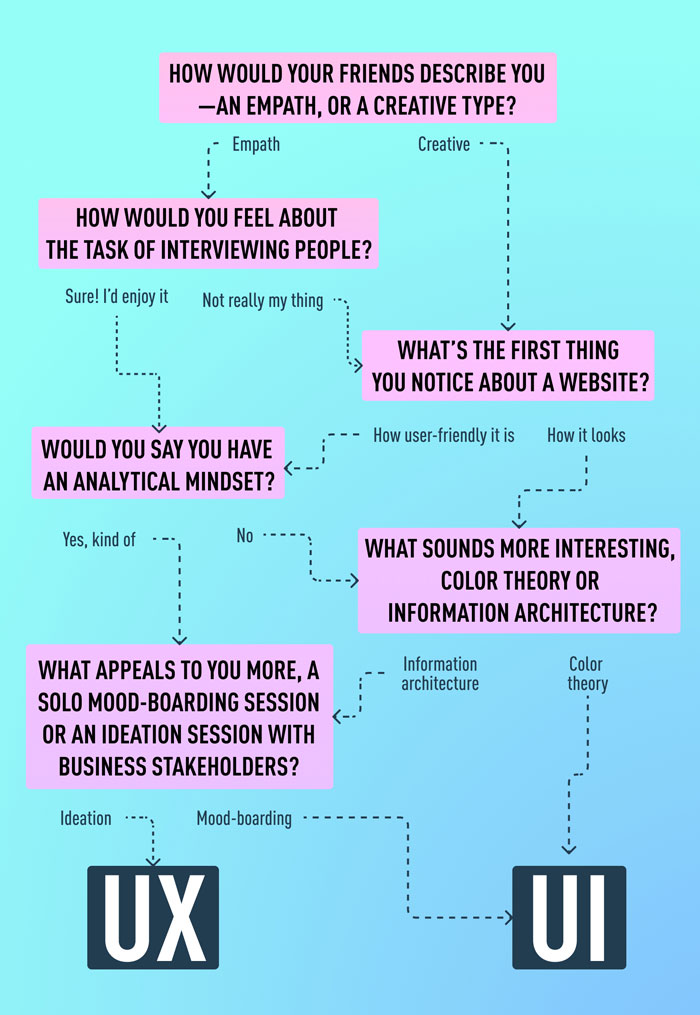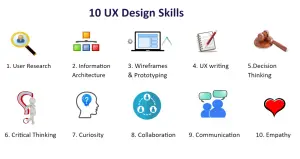Here's an overview:
What is UX Design?
User Experience (UX) design focuses on creating meaningful experiences for users when they interact with a product or service. It encompasses all aspects of the user’s interaction, ensuring that their needs are met efficiently and effectively. UX design involves understanding the users’ behaviors, motivations, and goals in order to design a seamless and user-friendly experience.
- User Research: UX design begins with in-depth research to gather insights about the target audience. This involves conducting surveys, interviews, and usability tests to understand user needs and preferences.
- Information Architecture: This aspect focuses on organizing and structuring content in a way that is intuitive and easy for users to navigate. Information architecture involves creating sitemaps and wireframes to plan out the structure of the product.
- Interaction Design: Interaction design is concerned with creating interactive elements that allow users to engage with the product. This includes designing user flows, interface elements, and microinteractions to enhance the user experience.
- Usability Testing: UX designers conduct usability testing to evaluate the effectiveness of the design. Through testing, designers can identify any usability issues and make improvements to enhance the overall user experience.
In essence, UX design is crucial for creating products that are user-centric and provide value to the target audience. By understanding user needs and behaviors, UX designers can create experiences that are intuitive, engaging, and satisfying for users.
What is UI Design?

UI design, short for User Interface design, focuses on creating visually appealing and aesthetically pleasing interfaces for digital products. This design discipline ensures that the look and feel of an app or website is not only visually enticing but also functional and user-friendly.
- Visual Elements: UI design encompasses the visual aspects of a digital product, including color schemes, typography, buttons, icons, and interactive elements. Designers carefully consider these elements to create a cohesive and engaging user interface.
- Layout: The arrangement of elements on a screen is crucial in UI design. Designers work on designing intuitive layouts that guide users through the interface and help them find information easily. A well-thought-out layout can significantly enhance user experience.
- Interaction Design: UI designers also focus on interaction design, which involves creating engaging and interactive elements for users to interact with. This could include animations, transitions, and micro-interactions that make the user experience more dynamic and enjoyable.
- Consistency: Maintaining consistency throughout the interface is essential in UI design. Consistent use of colors, typography, iconography, and interactive elements helps users navigate the interface seamlessly and builds a sense of familiarity.
- Responsiveness: With the growing number of devices with different screen sizes, UI designers must ensure that interfaces are responsive and adapt to various screen sizes. Responsive design plays a crucial role in providing a consistent user experience across different devices.
In essence, UI design is about creating interfaces that are not only visually appealing but also intuitive, user-friendly, and responsive. A well-executed UI design can significantly enhance the overall user experience and contribute to the success of a digital product.
What is a UX Designer, and What Do UX Designers Do?
- A UX designer, short for user experience designer, is a professional responsible for designing the overall feel of a product or service to ensure optimal user experience.
- UX designers focus on creating meaningful and relevant experiences for users by enhancing usability, accessibility, and pleasure in the interaction between the user and the product.
- Key responsibilities of a UX designer include conducting user research, creating user personas, designing wireframes and prototypes, and collaborating with stakeholders to ensure the product meets user needs.
- User research involves studying user behavior, needs, and motivations to gain insights that drive design decisions and improve the overall user experience.
- User personas are fictional characters created to represent different user types, helping UX designers design with specific user needs and scenarios in mind.
- Wireframes are basic visual representations of the layout and structure of a product, while prototypes are interactive versions used for user testing and feedback.
- Collaboration with stakeholders, such as developers, marketers, and designers, is crucial for UX designers to align on goals, constraints, and feedback throughout the design process.
- Ultimately, UX designers aim to create intuitive, user-friendly experiences that meet user needs and business goals effectively.
- In summary, UX designers play a vital role in crafting digital products and services that prioritize user satisfaction and usability.
What skills do UX designers need?
- Strong User Empathy: UX designers must have the ability to understand and empathize with the users they are designing for. This skill allows them to create intuitive and user-friendly designs.
- Research Skills: UX designers need to be proficient in conducting user research to gather valuable insights. They should be able to analyze data effectively to inform their design decisions.
- Wireframing and Prototyping: Proficiency in creating wireframes and prototypes is essential for UX designers. These tools help bring their design ideas to life and allow for testing and refinement before the final product is developed.
- Information Architecture: UX designers should have a solid understanding of information architecture to structure content in a logical and intuitive way. This skill ensures that users can easily navigate through the interface.
- Collaboration: Working collaboratively with other team members, such as UI designers, developers, and stakeholders, is crucial for UX designers. They need to effectively communicate their design decisions and be open to feedback.
- Visual Design Skills: While UI designers typically handle the visual aspects of a design, UX designers should still have a good eye for design. Understanding basic design principles can help them create more effective user experiences.
- Problem-Solving Abilities: UX designers need to be adept problem solvers, as they often encounter complex challenges in the design process. They should be able to think creatively and come up with innovative solutions.
- Technical Proficiency: Having a basic understanding of front-end development technologies can be beneficial for UX designers. It allows them to better collaborate with developers and ensure that their designs are feasible to implement.
- Communication Skills: Clear communication is essential for UX designers, as they need to articulate their design decisions to various stakeholders. They should also be able to present their ideas effectively and justify their design choices.
- Adaptability: The field of UX design is constantly evolving, so UX designers need to be flexible and willing to learn new tools and techniques. Staying updated on industry trends and best practices is crucial for success in this field.
What is a UI Designer and what do UI designers do?

A UI designer, short for User Interface designer, is a professional responsible for creating the look and feel of a digital product. Their primary focus is on the visual elements users interact with, such as buttons, icons, color schemes, and typography. UI designers work closely with UX designers to ensure that the overall user experience is seamless and intuitive.
Responsibilities of a UI Designer:
- Visual Design: Creating visually appealing layouts and elements that align with the brand image and enhance user experience.
- Prototyping: Developing interactive prototypes to showcase design concepts and gather feedback for iterations.
- Collaboration: Working closely with cross-functional teams, including UX designers, developers, and product managers, to ensure design consistency.
- User Research: Conducting user testing and gathering insights to inform design decisions and improve usability.
- Interface Animation: Implementing animations and transitions to enhance user interactions and create a dynamic user experience.
UI designers utilize various tools such as Sketch, Adobe XD, Figma, and prototyping tools like InVision or Marvel to create high-fidelity designs and interactive prototypes. They also stay updated with design trends, usability principles, and emerging technologies to deliver cutting-edge designs that resonate with users.
In essence, UI designers are pivotal in translating UX design concepts into aesthetically pleasing and functional interfaces that engage users effectively.
What are the different types of UI?
- Graphical User Interface (GUI): GUI is the most common type of UI that utilizes visual elements like icons, buttons, and menus to interact with a device or software. It is user-friendly and widely used in operating systems and applications.
- Voice User Interface (VUI): VUI allows users to interact with devices through spoken commands. Virtual assistants like Siri and Alexa are examples of VUI that have gained popularity in recent years.
- Touch User Interface (TUI): TUI enables users to interact with devices through touch gestures like tapping, swiping, and pinching. It is commonly found in smartphones, tablets, and other touchscreen devices.
- Gesture User Interface (GUI): GUI recognizes hand movements and gestures to control devices or applications. This type of UI is prevalent in gaming consoles, virtual reality systems, and motion-sensing technologies.
- Command Line Interface (CLI): CLI requires users to type specific commands to perform tasks. Although not as visually appealing as GUI, CLI is still used for advanced system configurations and programming tasks.
- Natural Language User Interface (NUI): NUI allows users to interact with devices using natural language, like text or speech. Language processing technologies are employed to understand and respond to user input.
- Augmented Reality Interface (AR UI): AR UI overlays digital information onto the real world, providing an interactive experience through devices like smart glasses or smartphones. It enhances the user’s perception of reality.
Understand the distinctions between these various types of UI is crucial for UX/UI designers to create intuitive and user-friendly interfaces tailored to the specific needs of their target audience.
What skills do UI designers need?
- Visual Design Skills:
- UI designers need to have a strong sense of visual design principles to create aesthetically pleasing interfaces that are visually appealing and easy to navigate.
- They should have a good understanding of colors, typography, layout, and other design elements to create a visually cohesive and engaging user interface.
- User-Centric Design:
- UI designers must have a deep understanding of user behavior and psychology to design interfaces that are intuitive and user-friendly.
- They need to conduct user research, create user personas, and perform usability testing to ensure that the interface meets the needs and expectations of the target audience.
- Prototyping and Wireframing:
- Proficiency in prototyping and wireframing tools is crucial for UI designers to create interactive prototypes and mockups of the interface.
- They should be able to rapidly iterate on design ideas and concepts to test and refine the user interface before final implementation.
- Collaboration and Communication:
- UI designers need to work closely with UX designers, developers, and other team members to ensure that the design vision is effectively translated into the final product.
- Strong communication skills are essential to convey design ideas, provide constructive feedback, and align on design decisions with stakeholders.
- Technical Skills:
- Basic knowledge of front-end development technologies such as HTML, CSS, and JavaScript can be beneficial for UI designers to understand the technical limitations and possibilities of the interface.
- Familiarity with design tools like Adobe XD, Sketch, or Figma is essential for creating high-fidelity designs and collaborating with other team members effectively.
- Attention to Detail:
- UI designers need to have a keen eye for detail to ensure that the interface is pixel-perfect and maintains consistency across different devices and screen sizes.
- They should pay attention to small design elements, spacing, alignment, and interactions to create a polished and professional user interface.
What’s the difference between UX and UI?
- UX Design:
- Focuses on the overall user experience.
- Involves understanding user behaviors, needs, and motivations.
- Aims to make products easy to use and efficient.
- Involves research, testing, and iteration to enhance user satisfaction.
- UI Design:
- Concentrates on the visual aspects of a product.
- Involves designing each screen or page with which a user interacts.
- Concerned with the look and feel, presentation, and interactivity of a product.
- Focuses on creating aesthetically pleasing and consistent designs.
In essence, UX design is more about the overall feel of the product, ensuring it is user-friendly and addresses user needs effectively. On the other hand, UI design is more about the look and layout, creating visually appealing interfaces and ensuring a cohesive design aesthetic throughout the product.
Key Differences:
- UX is about the overall experience, focusing on how the product feels.
- UI is about the look and layout, concentrating on how the product is presented.
- UX is more analytical and research-oriented.
- UI is more concerned with design aspects and visual elements.
Understanding these differences is essential for businesses and designers to create successful digital products that not only look great but also provide an exceptional user experience.
What is a UX / UI designer?
A UX/UI designer is a professional responsible for creating the overall experience of a product or service and ensuring that it is user-friendly and visually appealing. Here are some key points to understand what a UX/UI designer does:
- User Experience (UX) Design:
- UX designers focus on understanding the user’s needs, behaviors, and motivations. They create wireframes, prototypes, and conduct user research to design the overall flow and interaction of a product.
- Their goal is to enhance the ease of use, accessibility, and pleasure provided in the interaction between the user and the product.
- User Interface (UI) Design:
- UI designers are more concerned with the look and feel of a product. They work on the visual elements, such as buttons, icons, and typography, to make the product aesthetically pleasing.
- They ensure that the design is consistent across the product and aligned with the brand identity.
- Collaboration:
- UX/UI designers often work closely with product managers, developers, and other stakeholders to understand the project requirements and translate them into effective design solutions.
- Collaboration is key to ensuring that the final product meets both user needs and business goals.
- Tools:
- UX/UI designers use a variety of tools such as Adobe XD, Sketch, Figma, and InVision to create designs, prototypes, and collaborate with team members.
UX/UI designers play a crucial role in the success of a product by combining user research, design principles, and business objectives to create a seamless and engaging experience for the end-users.
Is UX / UI design a good career?
In the realm of design and technology, UX/UI design is a highly sought-after and rewarding career path that continues to gain prominence. Here are some reasons why pursuing a career in UX/UI design can be a fruitful choice:
- High demand: With the digital landscape evolving rapidly, the demand for skilled UX/UI designers is consistently on the rise. Companies across various industries are recognizing the crucial role of design in creating successful products and are actively seeking professionals in this field.
- Competitive salaries: Due to the specialized skill set and expertise required in UX/UI design, professionals in this field typically command competitive salaries. This can make it a financially lucrative career choice for individuals looking to embark on a design-focused path.
- Creative opportunities: UX/UI design offers abundant creative opportunities for professionals to innovate, problem-solve, and craft user-centric solutions. Designers have the chance to work on diverse projects, collaborate with cross-functional teams, and contribute to shaping products that impact user experiences.
- Continuous learning: The field of UX/UI design is dynamic and ever-evolving, providing ample opportunities for designers to engage in continuous learning and skill development. This constant evolution ensures that professionals stay up-to-date with the latest design trends, tools, and methodologies.
- Job satisfaction: Designing products that improve user experiences and solve real-world problems can be immensely rewarding. UX/UI designers often find fulfillment in creating intuitive interfaces, enhancing usability, and making a positive impact on how users interact with technology.
Embarking on a career in UX/UI design can offer a blend of creativity, technical skills, and impactful work that appeals to individuals passionate about design and user experience.
What is the salary of a UX / UI designer?
- The salary of a UX/UI designer can vary based on factors such as experience, location, and the specific company.
- Entry-level UX/UI designers typically earn around $50,000 to $70,000 annually.
- Mid-level designers with a few years of experience can expect to make between $75,000 and $100,000 per year.
- Senior UX/UI designers, with significant experience and a strong portfolio, may earn upwards of $100,000, with some exceeding $150,000 annually.
- Factors that can influence salary include the size and industry of the company, the designer’s skill level, and the demand for UX/UI expertise in the market.
- Larger tech companies and design agencies often pay higher salaries compared to smaller companies or non-profit organizations.
- Location also plays a significant role in determining salary, with metropolitan areas and tech hubs typically offering higher salaries than smaller towns or rural areas.
- It is not uncommon for UX/UI designers to receive additional benefits such as bonuses, stock options, and healthcare packages as part of their compensation package.
- Continuing education, certifications, and a strong portfolio can also help designers command higher salaries in the competitive job market.
- Overall, UX/UI design is a lucrative field with ample opportunities for growth and advancement, making it an attractive career choice for creative individuals with a passion for user experience and interface design.
How do I become a UX / UI designer?
To become a successful UX/UI designer, individuals can follow these steps:
- Educational Background: Pursue a degree in a relevant field such as graphic design, human-computer interaction, or computer science.
- Gain Knowledge: Acquire knowledge in design principles, user experience research, interaction design, and visual design.
- Build Skills: Develop proficiency in design tools like Adobe Creative Suite, Sketch, Figma, or prototyping tools such as InVision or Axure.
- Hands-On Experience: Gain practical experience by working on projects, internships, or freelance opportunities to build a strong portfolio.
- Networking: Connect with other professionals in the industry, attend design events, seminars, and workshops to expand your network and learn from experts.
- Continuous Learning: Stay updated with the latest trends, tools, and technologies in the UX/UI design field through online courses, blogs, and books.
- Problem-Solving Skills: Improve problem-solving abilities by understanding user needs and creating solutions that enhance user satisfaction.
- Attention to Detail: Pay attention to the smallest details in design to ensure a seamless user experience.
- Seek Feedback: Be open to feedback from users, colleagues, and mentors to further enhance your design skills.
- Specialize: Consider specializing in a specific area of UX/UI design such as mobile design, web design, or user research to further refine your skills and expertise.
By following these steps and continuously honing your skills, you can embark on a successful career as a UX/UI designer.
The Future of UX Design
- With the rapid advancements in technology, the future of UX design is exciting and evolving at a fast pace.
- Artificial intelligence and machine learning are poised to revolutionize UX design by personalizing user experiences.
- Voice interfaces, augmented reality, and virtual reality present new challenges and opportunities for UX designers.
- Inclusivity and accessibility will continue to be key focuses in UX design to ensure that products are usable by all individuals.
- Data-driven design decisions will become even more critical as UX designers leverage user data to create more intuitive and user-friendly experiences.
- Collaboration between UX designers, developers, and other stakeholders will be essential for creating seamless and cohesive user experiences.
- UX design will increasingly incorporate elements of emotional design to create more engaging and impactful products.
- The role of UX designers in shaping the overall product strategy and vision will continue to expand, highlighting the importance of UX design in business success.
- Continuous learning and adaptation will be crucial for UX designers to stay relevant in a rapidly changing landscape of technology and design trends.
- As UX design becomes more central to business strategies, a strong emphasis on user research and testing will be critical for creating successful products that meet user needs and preferences.
Choosing between UX and UI (From : “careerfoundry.com“)
If you’re keen to pursue a career in design but still aren’t sure whether to focus on UX or UI, you’ll need to spend some time thinking about where your interests lie, as well as what you’re naturally good at.
Both UX and UI design are highly collaborative, varied career paths, placing you right at the cutting edge of technology and innovation. With that said, there are some key differences between the nature of the work and the skills required.
Why not try out this quick flowchart to get an idea of what path might be the best fit for you?

A career in UX requires empathy, a penchant for problem-solving, and an approach that is both creative and analytical. UX designers also need first-rate communication skills and a little bit of business know-how.
A career in UI also requires an understanding of user experience principles, but it’s much more focused on the visual, interactive aspects of design. If you’ve got a keen eye for aesthetics and like the idea of making technology beautiful, user-friendly, and accessible, you might be more suited to a career in UI. Of course, if you like the idea of a career that combines both UI and UX, there’s nothing to stop you from becoming a design all-rounder!
What are FAQs about UX / UI design?
- What is the difference between UX and UI design? UX design focuses on the overall experience of a user interacting with a product, while UI design deals with the visual and interactive elements of the interface itself.
- Why is UX / UI design important for products? Good UX / UI design enhances user satisfaction, drives conversions, and ultimately leads to increased user engagement and loyalty.
- How do UX and UI designers work together? UX designers focus on understanding user needs and creating the overall functionality of a product, while UI designers concentrate on designing interfaces that are visually appealing and easy to use.
- What tools do UX / UI designers use? Common tools used by UX / UI designers include Adobe XD, Sketch, Figma, InVision, and Axure for creating wireframes, prototypes, and high-fidelity designs.
- How do you conduct user research for UX / UI design? User research methods such as user interviews, surveys, usability testing, and analytics are commonly employed to gather insights into user behavior and preferences.
- Can anyone become a UX / UI designer? While a design background can be helpful, anyone with a passion for creating enjoyable user experiences and a willingness to learn can pursue a career in UX / UI design.
- What are the current trends in UX / UI design? Trends like dark mode, minimalist design, micro-interactions, voice user interfaces, and augmented reality are shaping the landscape of UX and UI design in modern products.





